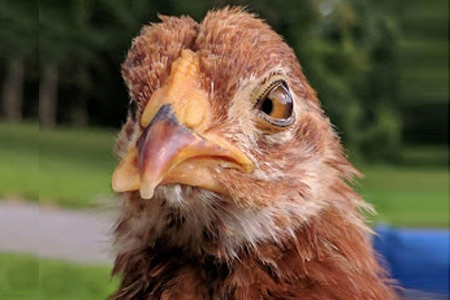
A chicken’s beak is an important tool for gathering food, drinking water, and exploring and manipulating objects in the environment. A chicken also uses its beak for preening, nest building, and engaging in social interactions. But occasionally a chick hatches with, or later develops, a deformity known as crossbeak.
Also called crossed beak or scissors beak, this condition occurs when the upper half of the beak grows in the opposite direction from the lower half. The chicken therefore cannot properly close its beak and has trouble eating, drinking, or engaging in other normal activities. Causes of crossbeak are varied and numerous.
Crossbeak Causes
When a chick has a crossed beak at hatch, or soon thereafter, the cause could be genetic. It could also result from malposition of the embryo or excessive humidity during incubation.
As a genetic issue, crossed beak is especially common in Ameraucanas and Easter Eggers. It’s a problem breeders have been trying for decades to eradicate without success. Since crossbeak can be hereditary, do not hatch eggs laid by a crossbeak hen or fertilized by a crossbeak rooster.
Crossbeak that develops later in a chicken’s life might be caused by an infection or an injury that throws the jaw out of whack, resulting in the top and bottom half of the beak no longer aligning properly. Another cause could be improper diet fed to the breeder flock or to growing chicks. Poor nutritional balance can result from feeding too many treats, storing feed in a hot environment or for so long that it goes stale, or an improperly mixed homemade ration.
Managing Crossed Beak
A crossed beak can interfere with the chicken’s ability to eat and drink normally. You can help ensure the bird gets enough to eat by offering mash moistened with a bit of yogurt or plain water.
If you are otherwise feeding pelleted ration, crush the pellets in a food processor before moistening. Sometimes flockmates will try to keep the crossbeak chicken from eating, in which case consider feeding it separately.
Since the crossbeak chicken can’t peck using both beak halves, it adapts by scooping feed with the lower half. Still, the chicken often has trouble getting enough to eat, and therefore is usually quite a bit smaller than others of the same age.
Beak Trimming
A chicken’s beak grows constantly, like our fingernails. By pecking and beak wiping, the chicken naturally keeps its beak trimmed down. Although a chicken with crossbeak can’t peck properly, it may wipe its beak. To encourage beak wiping, place a couple of bricks or other rough objects in the chicken yard for the birds to rub their beaks against.
A chicken with a severely crossed beak may require occasional beak trimming. However, an improper trim can make things worse. And careless trimming can result in excessive bleeding. So it’s best to have an experienced person, such as an avian veterinarian, show you what needs to be done. And the veterinarian may know other techniques to help manage the crossed beak.
Crossbeak can be so mild it in no way impairs the chicken’s health. Or it can be severe enough to present a serious, or even fatal, health issue. But with careful management, even a chicken with a seriously crossed beak can get along nearly as well as any other bird in the flock.
And that’s today’s news from the Cackle Coop.
Gail Damerow has written numerous poultry-keeping books, many of them available from the Cackle Bookstore.

